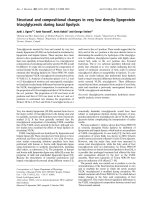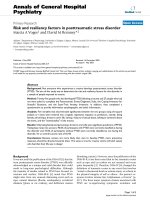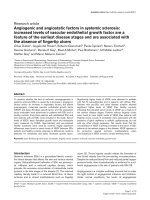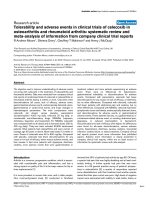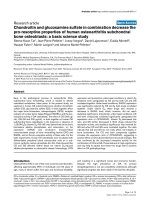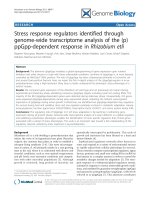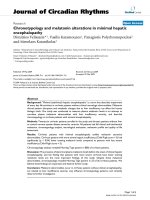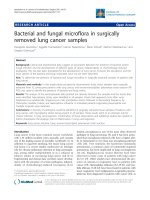Báo cáo y học: " Foot and ankle surgery in Australia: a descriptive analysis of the Medicare Benefits Schedule database, 1997–2006" potx
Bạn đang xem bản rút gọn của tài liệu. Xem và tải ngay bản đầy đủ của tài liệu tại đây (302.66 KB, 10 trang )
BioMed Central
Page 1 of 10
(page number not for citation purposes)
Journal of Foot and Ankle Research
Open Access
Research
Foot and ankle surgery in Australia: a descriptive analysis of the
Medicare Benefits Schedule database, 1997–2006
Hylton B Menz*
1
, Mark F Gilheany
1,2
and Karl B Landorf
1,2
Address:
1
Musculoskeletal Research Centre, Faculty of Health Sciences, La Trobe University, Bundoora, Victoria 3086, Australia and
2
Department
of Podiatry, Faculty of Health Sciences, La Trobe University, Bundoora, Victoria 3086, Australia
Email: Hylton B Menz* - ; Mark F Gilheany - ; Karl B Landorf -
* Corresponding author
Abstract
Background: Foot and ankle problems are highly prevalent in the general community and a
substantial proportion of people seek surgical treatment to alleviate foot pain and deformity.
However, the epidemiology of foot and ankle surgery has not been examined in detail. Therefore,
the aim of this study was to examine patterns and costs of private sector foot surgery provision in
Australia.
Methods: Data pertaining to all foot and ankle surgical procedures for the calendar years 1997–
2006 were extracted from the Australian Medicare Benefits Schedule (MBS) database and were
cross-tabulated by sex and age. Descriptive analyses were undertaken to assess sex and age
differences in the number and type of procedures performed and to assess for temporal trends
over the ten year assessment period. The total cost to Medicare of subsiding surgeons' fees in 2006
was also determined.
Results: During the 1997–2006 period, 996,477 surgical procedures were performed on the foot
and ankle by private surgeons in Australia. Approximately equal numbers of procedures were
performed on males (52%) and females (48%). However, males were more likely to undergo
toenail, ankle, clubfoot, tarsal coalition and congenital vertical talus surgery, whereas females were
more likely to undergo lesser toe, first metatarsophalangeal joint (MPJ), neuroma, heel, rearfoot
and lesser MPJ surgery. The total number of procedures was stable over the assessment period,
however there was a relative increase in the number of procedures performed on people aged over
55 years. The total contribution of Medicare to subsiding surgeons' fees for procedures performed
in 2006 was $14 M.
Conclusion: Foot and ankle surgery accounts for a considerable degree of healthcare expenditure
in Australia, and the number of procedures in those aged over 55 years is increasing. Given the
ageing demographics of the Australian population, the future public health and economic impact of
foot morbidity is likely to be substantial. Strategies need to be implemented to ensure that the
surgical labour force is adequate to address this increasing demand.
Published: 15 September 2008
Journal of Foot and Ankle Research 2008, 1:10 doi:10.1186/1757-1146-1-10
Received: 3 July 2008
Accepted: 15 September 2008
This article is available from: />© 2008 Menz et al; licensee BioMed Central Ltd.
This is an Open Access article distributed under the terms of the Creative Commons Attribution License ( />),
which permits unrestricted use, distribution, and reproduction in any medium, provided the original work is properly cited.
Journal of Foot and Ankle Research 2008, 1:10 />Page 2 of 10
(page number not for citation purposes)
Background
Foot problems are reported by at least one in five people
in the general population [1,2], and are associated with
self-reported disability [3] and reduced health-related
quality of life [2,4,5]. Although many common foot prob-
lems can be effectively managed by conservative interven-
tions such as lesion debridement, physiotherapeutic
modalities, orthotic therapy and footwear modifications,
major structural or long-standing conditions often require
surgical intervention. In Australia, provision of foot sur-
gery is primarily the domain of specialist orthopaedic sur-
geons. However, general surgeons and general
practitioners may also perform foot and ankle surgical
procedures, and a small number of surgically-trained
podiatrists perform forefoot surgery in the private sector
[6,7].
Foot and ankle surgery in Australia is heavily subsidised
by Medicare, a universal healthcare system financed
through income tax and an income-related Medicare levy.
Governed by the Australian Health Care Agreements
between the Commonwealth and the states, Medicare
covers the full cost of procedures performed by public sur-
geons in public hospitals, and 75% of the scheduled fee
for procedures performed by private surgeons. Additional
private hospital costs (such as theatre fees) are not covered
by Medicare, and are generally met by private health
insurance [8]. Podiatric surgeons do not attract a Medicare
subsidy, however several private health insurance funds
provide rebates for their services [6].
Surgical activity in Australia is continuously tracked by the
Medicare Benefits Schedule (MBS) database [9], which
records all services performed by registered providers that
qualify for a Medicare benefit, with the exception of: (i)
services provided by hospital doctors to public patients in
public hospitals; (ii) services that qualify for a benefit
under the Department of Veterans' Affairs, Work Cover or
the Transport Accident Commission, and; (iii) services
provided by podiatric surgeons. Although not completely
comprehensive, the MBS database is nevertheless a useful
resource for exploring the epidemiology and healthcare
costs of surgical procedures [10].
The aim of this study was to investigate patterns of foot
and ankle surgery provision in Australia, with particular
reference to: (i) the influence of age and sex on the type of
surgery performed; (ii) temporal trends in surgical provi-
sion over a ten-year period (1997–2006), and; (iii) the
total cost to Medicare of subsiding foot and ankle sur-
geons' fees in 2006.
Methods
Data extraction from the Medicare Benefits Schedule
database
Data pertaining to foot and ankle surgical procedures for
the calendar years 1997–2006 were extracted from the
publicly accessible Medicare Benefits Schedule (MBS)
database [9]. A summary of the item numbers and proce-
dures obtained is provided in Additional File 1. Each item
number dataset (consisting of the number of procedures
performed by sex, age-group and calendar year) was
extracted individually and exported into Microsoft Excel
(Microsoft Corp, Redmond USA) for analysis. MBS item
numbers for procedures that could not be isolated to the
foot and ankle (such as excision of soft tissue tumours,
treatment of burns, "generic" surgical items and multi-
level orthopaedic surgery) were excluded.
Costs per item number (in Australian dollars) were
obtained for the 2006 calendar year only, as the cost data
did not encompass the entire assessment period (1997–
2006).
To simplify the interpretation of the results, item numbers
relating to a similar region of the foot or a specific foot
condition were combined into one of the following 12
categories:
(i) toenail: wedge resection, partial resection and total
removal of toenails (item numbers 44136, 47904, 47906,
47912, 47915, 47916, 47918);
(ii) foot and ankle trauma: including treatment of disloca-
tions and fractures of the ankle, tarsals, metatarsals and
phalanges (item numbers 47063, 47066, 47069, 47072,
47594, 47597, 47600, 47603, 47606, 47609, 47612,
47615, 47618, 47621, 47624, 47627, 47630, 47633,
47636, 47639, 47642, 47645, 47648, 47651, 47654,
47657, 47663, 47666, 47672, 47678);
(iii) lesser toes: including primary and secondary repair of
flexor and extensor tendons, tenotomy, correction of
clawtoes, hammertoes and hyperextension deformity
(item numbers 49800, 49803, 49806, 49809, 49812,
49848, 49851 and 50345);
(iv) ankle: including diagnostic arthroscopy, arthroscopic
surgery, ligamentous stabilisation, arthrodesis, total joint
replacement and Achilles tendon procedures (item num-
bers 49700, 49703, 49706, 49709, 49712, 49715, 49718,
49721, 49724, 49727 and 50312);
(v) first metatarsophalangeal joint (1
st
MPJ): including
excisional arthroplasty, osteotomy, adductor hallucis ten-
don transfer, prosthetic arthroplasty and arthrodesis for
either hallux valgus or hallux rigidus (item numbers
Journal of Foot and Ankle Research 2008, 1:10 />Page 3 of 10
(page number not for citation purposes)
49821, 49824, 49827, 49830, 49833, 49836, 49837,
49838, 49839, 49842, 49845, 49857, 49860 and 49863);
(vi) neuroma: neurectomy for plantar digital neuritis
(item number 49866);
(vii) amputations: digital, transmetatarsal, Syme (item
numbers 44338, 44342, 44346, 44350, 44354, 44358,
44359, 44361, 44364);
(viii) clubfoot: including posterior release, medial release
or combined postero-medial release (item numbers
50315, 50318, 50321, 50324, 50327, 50339 and 50342);
(ix) heel: including excision of calcaneal spur and plantar
fasciotomy (item numbers 49818 and 49854);
(x) rearfoot: including triple arthrodesis and subtalar joint
arthrodesis (item numbers 49815 and 50118);
(xi) lesser metatarsophalangeal joints: synovectomy of
metatarsophalangeal joints (item numbers 49860 and
49863);
(xii) tarsal coalition and congenital vertical talus (item
numbers 50333 and 50336);
To calculate the total number of procedures performed
between 1997 and 2006, all item numbers pertaining to
bilateral procedures (49824, 49830, 49836, 49838,
49842 and 50327) were considered to represent two indi-
vidual procedures. However, when calculating total costs
for the year 2006, the cost for each item (unilateral or
bilateral) was used.
To evaluate trends in the total number of procedures per
year between 1997 and 2006, both absolute and adjusted
figures were calculated, as approximately two million
additional people were enrolled in Medicare over the
assessment period. To determine the number of proce-
dures relative to the number of people enrolled, the
number of eligible people for the last quarter of each year
was extracted from the database, and the number of pro-
cedures was expressed per 100,000. However, because the
database does not report sex or age of those enrolled, it
was not possible to determine whether trends over time
differed according to these characteristics.
Statistical analysis
Data were analysed using simple descriptive statistics
(total number of procedures cross-tabulated by sex, age-
group and calendar year), as the publicly accessible ver-
sion of the MBS database we used does not allow for the
extraction of individual-level data. For each category of
procedures, the proportion of item numbers documented
for males and females was determined and expressed as a
ratio.
Results
All procedures
Using our audit methodology, between 1997 and 2006, a
total of 996,477 surgical procedures attracting a Medicare
rebate were performed on the foot and ankle by private
surgeons (excluding podiatric surgeons) in Australia. The
most frequently performed surgical category was toenail
surgery (64%), followed by trauma (16%), lesser toe (6%)
and ankle (6%) surgery. Approximately equal numbers of
procedures were performed on males (52%) and females
(48%). The distribution of procedures according to age
demonstrated two peaks: one for the 15 to 24 year age-
group and one for the 55 to 64 year age-group (see Figure
1). Between 1997 and 2006, the total number of proce-
dures performed remained reasonably stable (ranging
from 94,217 to 104,538 procedures per year, or 81 to 124
procedures per year per 100,000 people enrolled). How-
ever, there was a relative decrease in the number of proce-
dures in those aged 0 to 44 years, and a relative increase in
those aged 45 years and over (see Figure 2).
Toenail procedures
A total of 630,744 surgical procedures were performed on
toenails, with a male to female ratio of 1.39. The highest
proportion of procedures was performed on the 15 to 24
year age group (see Figure 3a).
Trauma procedures
A total of 158,604 surgical procedures were performed for
foot and ankle trauma, with a male to female ratio of 1.09.
The highest proportion of procedures was performed on
the 15 to 24 year age group (see Figure 3b).
Lesser toe procedures
A total of 64,764 surgical procedures were performed on
the lesser toes, with a female to male ratio of 3.88. The
highest proportion of procedures was performed on the
55 to 64 year age group (see Figure 3c).
Ankle procedures
A total of 61,113 surgical procedures were performed on
the ankle, with a male to female ratio of 1.51. The highest
proportion of procedures was performed on the 35 to 44
year age group (see Figure 3d).
1
st
MPJ procedures
A total of 46,727 surgical procedures were performed on
the 1
st
MPJ, with a female to male ratio of 5.35. The high-
est proportion of procedures was performed on the 55 to
64 year age group (see Figure 3e).
Journal of Foot and Ankle Research 2008, 1:10 />Page 4 of 10
(page number not for citation purposes)
Neuroma procedures
A total of 11,037 surgical procedures were performed on
intermetatarsal neuromas, with a female to male ratio of
3.78. The highest proportion of procedures was per-
formed on the 55 to 64 year age group (see Figure 3f).
Amputation procedures
A total of 8,463 surgical procedures were performed for
foot amputation, with a male to female ratio of 1.13. The
highest proportion of procedures was performed on the
75 to 84 year age group (see Figure 3g).
Clubfoot procedures
A total of 1,950 surgical procedures were performed for
clubfoot, with a male to female ratio of 1.61. The highest
proportion of procedures was performed on the 0 to 4
year age group (see Figure 3h).
Heel procedures
A total of 5,446 surgical procedures were performed on
the heel, with a female to male ratio of 1.67. The highest
proportion of procedures was performed on the 45 to 54
year age group (see Figure 4a).
Total number of surgical procedures performed between 1997 and 2006 according to age and sexFigure 1
Total number of surgical procedures performed between 1997 and 2006 according to age and sex.
RYHU
QXPEHURISURFHGXUHV
DJHJURXS
IHPDOH
PDOH
WRWDO
Percentage change in the total number of procedures performed between 1997 and 2006 according to ageFigure 2
Percentage change in the total number of procedures performed between 1997 and 2006 according to age.
RYHU
DJHJURXS
FKDQJHEHWZHHQDQG
Journal of Foot and Ankle Research 2008, 1:10 />Page 5 of 10
(page number not for citation purposes)
Total number of procedures by surgical category between 1997 and 2006 according to age and sex (females – grey bars, males – white bars, total – line)Figure 3
Total number of procedures by surgical category between 1997 and 2006 according to age and sex (females –
grey bars, males – white bars, total – line).
D7RHQDLO E7UDXPD
RYHU
RYHU
F/HVVHUWRHV G$QNOH
RYHU
RYHU
H
VW
03- I1HXURPD
RYHU
RYHU
J$PSXWDWLRQ K&OXEIRRW
RYHU
RYHU
Journal of Foot and Ankle Research 2008, 1:10 />Page 6 of 10
(page number not for citation purposes)
Rearfoot procedures
A total of 3,855 surgical procedures were performed on
the rearfoot, with a female to male ratio of 1.33. The high-
est proportion of procedures was performed on the 55 to
64 year age group (see Figure 4b).
Lesser MPJ procedures
A total of 2,800 surgical procedures were performed on
the lesser MPJs, with a female to male ratio of 2.87. The
highest proportion of procedures was performed on the
55 to 64 year age group (see Figure 4c).
Tarsal coalition and congenital vertical talus procedures
A total of 941 and 33 surgical procedures were performed
for tarsal coalition and congenital vertical talus, respec-
tively. Surgery for tarsal coalition and congenital vertical
talus was more commonly performed on males (male to
female ratios of 1.52 and 1.75, respectively). The highest
proportion of procedures for both conditions were per-
formed on people aged between 5 and 14 years of age (see
Figure 4d).
Changes over time by procedure
Examination of the number of procedures performed over
time indicated a steady increase in the number of lesser
toe, ankle, 1
st
MPJ, botulinum toxin, rearfoot and lesser
MPJ procedures, no change in the number of toenail,
trauma, neuroma, amputation, clubfoot and tarsal coali-
tion/congenital vertical talus procedures, and a steady
decrease in the number of heel procedures (data not
shown). Of particular note, there was a marked reduction
in the number of procedures undertaken for the excision
of calcaneal spurs (item number 49818). See Figure 5.
Costs
In 2006, 96,217 foot and ankle surgery items were docu-
mented, resulting in a total Medicare contribution to sur-
geons' fees of $14,128,342. The highest expenditure by
according to procedure type was for toenail surgery ($4.73
M, or 33% of total expenditure). A summary of total
expenditure for each procedure category is shown in Fig-
ure 6.
Total number of procedures by surgical category between 1997 and 2006 according to age and sex (females – grey bars, males – white bars, total – line)Figure 4
Total number of procedures by surgical category between 1997 and 2006 according to age and sex (females – grey bars, males
– white bars, total – line).
D+HHO E5HDUIRRW
RYHU
RYHU
F/HVVHU03-V G7DUVDOFRDOLWLRQFRQJHQLWDOYHUWLFDOWDOXV
RYHU
RYHU
Journal of Foot and Ankle Research 2008, 1:10 />Page 7 of 10
(page number not for citation purposes)
Discussion
The aim of this study was to explore the epidemiology and
costs of foot and ankle surgery in Australia using data rou-
tinely tracked by the Medicare Benefits Schedule (MBS)
database, in order to inform future planning of foot sur-
gery provision. Before discussing the findings in detail, it
is worth considering several limitations inherent in the
database. First, the MBS database does not cover services
provided by hospital doctors to public patients in public
hospitals, services that qualify for a benefit under the
Department of Veterans' Affairs, Work Cover or the Trans-
port Accident Commission, or services provided by podi-
atric surgeons. As such, the data presented here cannot be
considered comprehensive. Second, the publicly accessi-
ble version of the database does not delineate between
types of surgical providers (e.g.: general surgeons or ortho-
paedic surgeons), so no analyses could be performed to
compare patterns of surgical provision between these
groups. Third, although foot and ankle surgery often
involves multiple item numbers per procedure (e.g.: com-
bined hallux valgus and hammertoe surgery), MBS data is
recorded according to individual item codes. Therefore,
the database cannot be used to ascertain the number of
patients undergoing foot surgery. Fourth, by excluding
items which are commonly documented for foot surgery
but do not specifically pertain to the foot, the incidence of
foot surgery reported here is an underestimate. Finally,
analysis of the database was restricted to descriptive statis-
tics, as individual-level data cannot be extracted.
Total number of surgical procedures undertaken for the excision of calcaneal spurs (MBS item number 49818) performed per year between 1997 and 2006Figure 5
Total number of surgical procedures undertaken for
the excision of calcaneal spurs (MBS item number
49818) performed per year between 1997 and 2006.
FDOHQGDU\HDU
QXPEHURISURFHGXUHV
Expenditure according to procedure category in 2006Figure 6
Expenditure according to procedure category in 2006. NB: 1
st
MPJ – first metatarsophalangeal joint; CVT –
congenital vertical talus.
WDUVDOFRDOLWLRQ&97
OHVVHU03-V
DPSXWDWLRQV
KHHO
FOXEIRRW
UHDUIRRW
QHXURPD
OHVVHUWRHV
VW03-
WUDXPD
DQNOH
WRHQDLO
H[SHQGLWXUHV
Journal of Foot and Ankle Research 2008, 1:10 />Page 8 of 10
(page number not for citation purposes)
Despite these limitations, our analysis of the MBS data-
base yielded several interesting findings. Overall, nearly
one million surgical procedures were performed on the
foot and ankle between 1997 and 2006, and the total cost
of subsidising surgeons' fees in the most recent assess-
ment year was $14 M. By far the most commonly per-
formed surgery type was toenail surgery, accounting for
64% of all procedures and 33% of total expenditure in
2006. Somewhat surprisingly, the total number of proce-
dures per calendar year was reasonably stable over time,
although temporal trends varied according to age and pro-
cedure type. While there appears to have been a reduction
in the number of procedures performed on younger peo-
ple, there has been a significant increase in the number of
procedures performed on older people, particularly those
aged 55 to 64 years. Consistent with this observation, the
total number of procedures for conditions commonly
affecting younger people (such as toenail and clubfoot
surgery) decreased between 1997 and 2006, whereas pro-
cedures more commonly performed on older people
(such as lesser toe and 1
st
MPJ surgery) demonstrated sig-
nificant increases over this period.
Notably, between 1997 and 2006 there was a marked
reduction in the number of procedures undertaken for the
excision of calcaneal spurs. In 1997, 269 such procedures
were performed, and the number steadily declined to 95
in 2006. It is possible that this change reflects either an
increase in the number of people seeking conservative
treatment for heel pain, or a shift in surgical practice in
response to: (i) research questioning the role of calcaneal
spurs in the pathophysiology of heel pain [11]; or (ii) the
recent availability of extracorporeal shock wave therapy
[12], despite the limited evidence for its effectiveness [13].
Sex differences in the types of foot and ankle surgery
undertaken were generally consistent with available liter-
ature pertaining to the prevalence of various foot disor-
ders. Females were far more likely to undergo lesser toe,
1
st
MPJ, neuroma and lesser MPJ surgery, which reflects
the known female predisposition to these conditions
[1,14,15]. In adult females, this may be explained (at least
in part) by the detrimental effects of women's fashion
footwear, which often has an elevated heel and narrow
toebox [16]. Indeed, Coughlin and Thompson [17] have
estimated that in the US in 1991, 209,000 bunionecto-
mies, 210,000 hammer toe corrections, 119,000 bunio-
nette repairs and 66,500 neuroma resections were
performed (at a cost of approximately US$3 billion) for
shoe-related foot problems. However, not all procedures
were more common in females, with males being more
likely to undergo toenail, ankle, clubfoot, tarsal coalition
and congenital vertical talus surgery. While the epidemio-
logical literature pertaining to these foot conditions is
sparse, there is some evidence that males are more likely
to develop thickened nails [18], onychomycosis [19],
clubfoot [20-22] and tarsal coalition [23].
Age differences in the types of foot and ankle surgery
undertaken were also consistent with the known inci-
dence and prevalence of specific foot conditions. As
would be expected, surgical treatment for congenital con-
ditions such as clubfoot, vertical talus, tarsal coalition and
equino-valgus associated with cerebral palsy were almost
exclusively represented in those aged less than 10 years,
whereas amputations and treatment for chronic arthritic
disorders of the forefoot and rearfoot were over-repre-
sented in those aged 55 years and over. Interestingly, the
age distribution of procedures for foot and ankle trauma
exhibited a bimodal distribution, with one peak for the 15
to 24 age-group (with an over-representation of males),
and a second peak for people aged over 55 years (with an
over-representation of females). Although the underlying
mechanism for the trauma requiring surgery cannot be
ascertained from the database, it is likely that the first peak
primarily represents sporting injuries and occupational
foot and ankle trauma in young men [24,25], while the
second peak may be related to osteoporotic fractures asso-
ciated with accidental falls in older women [24,26].
To the authors' knowledge, there are only two similar
analyses that have been reported in the literature. The first
was a clinical audit of 785 cases of foot surgery conducted
by ten fellows of the Australasian College of Podiatric Sur-
geons between July 1995 and June 1996 [7]. This study
revealed that the most commonly performed procedures
were for lesser toe deformities (46%), followed by hallux
valgus (21%), intermetatarsal neuroma (8%) and hallux
limitus/rigidus (7%). Most patients were female (80%),
and the highest proportion of patients were aged 51 to 61
years. More recently, a population-based study of 6,956
inpatient cases in Sweden [27] indicated that the most
common surgical procedures undertaken were for the
treatment of hallux valgus (60%), followed by hammer
toes (24%) and hallux limitus/rigidus (15%). Consistent
with the present study findings, most of these procedures
were performed on women aged 50 to 70 years of age.
The findings reported in this study have important impli-
cations for surgical labour force planning. Although the
total number of procedures between 1997 and 2006
remained reasonably stable, there was a marked increase
in the number of procedures performed on those aged 55
to 64 years. Population projections by the Australian
Bureau of Statistics indicate that, due to declining birth
and death rates and the transition of the so-called "Baby
Boomer" generation into retirement age, Australia will
undergo a significant ageing of the population over the
next 50 years. In fact, by 2051, it is estimated that the
number of people aged over 65 years will double, and the
Journal of Foot and Ankle Research 2008, 1:10 />Page 9 of 10
(page number not for citation purposes)
number of people aged over 85 years will quadruple as a
relative proportion of the total population [28].
These demographic changes will undoubtedly result in a
significant increase in the number of older people requir-
ing surgical treatment for foot disorders, which will neces-
sitate a corresponding increase in the surgical workforce
to meet this need. In addition to training more orthopae-
dic surgeons, meeting this demand may require alterna-
tive strategies such as task substitution, whereby foot
surgery is undertaken by other healthcare professionals
such as podiatrists. Although the role of podiatric sur-
geons is well established in the US and UK, only recently
has orthopaedic task substitution been suggested in Aus-
tralia [29]. Given that there is some evidence from the US
that podiatric surgery is less expensive than orthopaedic
foot surgery (due to fewer hospital admissions [30]) and
that podiatric surgery in the UK reduces the need for
ongoing podiatry treatment [31], there may also be cost
savings associated with broader integration of podiatrists
into the Australian surgical workforce. This may be of par-
ticular relevance to toenail surgery, as simple nail avulsion
with phenolisation (commonly performed under local
anaesthesia by podiatrists) has been shown to be more
effective at preventing recurrence than surgical excision
techniques favoured by orthopaedic and general surgeons
[32]. However, such role flexibility may also be extended
to forefoot surgery, as evidence from the UK indicates
high levels of satisfaction (in both patients [33] and refer-
ring general practitioners [34]) with podiatric surgeons
undertaking these procedures.
Conclusion
Foot and ankle surgery accounts for a considerable degree
of healthcare expenditure in Australia. Given the ageing
demographics of the Australian population, the future
public health and economic impact of foot morbidity is
likely to be substantial. Strategies need to be implemented
to ensure that the surgical labour force is adequate to
address this increasing demand.
Competing interests
HBM and KBL are Editor-in-Chief and Deputy Editor-in-
Chief, respectively, of the Journal of Foot and Ankle
Research. It is journal policy that editors are removed from
the peer review and editorial decision making processes
for papers they have co-authored.
Authors' contributions
HBM and MFG conceived the study. HBM extracted, ana-
lysed and interpreted the data, and drafted the manu-
script. MFG and KBL assisted with data interpretation. All
authors read and approved the final version of the manu-
script.
Additional material
Acknowledgements
HBM is currently a National Health and Medical Research Council fellow
(Clinical Career Development Award, ID: 433049).
References
1. Garrow AP, Silman AJ, Macfarlane GJ: The Cheshire foot pain and
disability survey: A population survey assessing prevalence
and associations. Pain 2004, 110:378-384.
2. Hill CL, Gill T, Menz HB, Taylor AW: Prevalence and correlates
of foot pain in a population-based study: The North West
Adelaide Health Study. J Foot Ankle Res 2008, 1:2.
3. Keysor JJ, Dunn JE, Link CL, Badlissi F, Felson DT: Are foot disor-
ders associated with functional limitation and disability
among community-dwelling older adults? J Aging Hlth 2005,
17:734-752.
4. Chen J, Devine A, Dick IM, Dhaliwal SS, Prince RL: Prevalence of
lower extremity pain and its association with functionality
and quality of life in elderly women in australia. J Rheumatol
2003, 30:2689-2693.
5. Menz HB, Tiedemann A, Kwan MMS, Plumb K, Lord SR: Foot pain
in community-dwelling older people: An evaluation of the
Manchester Foot Pain and Disability Index. Rheumatology 2006,
45:863-867.
6. Australasian College of Podiatric Surgeons [http://
www.acps.edu.au/about_podiatric_surgery.html]
7. Bennett PJ: Prevalence and type of foot surgery performed in
Australia: A clinical review. Foot 2007, 17:197-204.
8. Duckett SJ: The Australian Health Care System 2nd edition. Melbourne:
Oxford University Press; 2004.
9. Medicare Benefits Schedule database [icar
eaustralia.gov.au/provider/medicare/mbs.shtml]
10. Askew DA, Wilkinson D, Schluter PJ, Eckert K: Skin cancer sur-
gery in australia 2001–2005: The changing role of the general
practitioner. Med J Aust 2007, 187:210-214.
11. Prichasuk S, Subhadrabandhu T: The relationship of pes planus
and calcaneal spur to plantar heel pain. Clin Orthop Relat Res
1994, 306:192-196.
12. Ogden JA, Alvarez R, Levitt R, Cross GL: Shock wave therapy for
chronic proximal plantar fasciitis. Clin Orthop Relat Res 2001,
387:47-59.
13. Thomson CE, Crawford F, Murray GD: The effectiveness of extra
corporeal shock wave therapy for plantar heel pain: A sys-
tematic review and meta-analysis. BMC Musculoskelet Disord
2005, 6:19.
14. Greenberg L: Foot care data from two recent nationwide sur-
veys. A comparative analysis. J Am Podiatr Med Assoc 1994,
84:365-370.
15. Brodie BS, Rees CL, Robins DJ, Wilson AFJ: Wessex feet: A
regional foot health survey, Volume I: The survey. Chiropodist
1988, 43:152-165.
16. Frey C, Thompson F, Smith J, Sanders M, Horstman H: American
Orthopedic Foot and Ankle Society women's shoe survey.
Foot Ankle 1993, 14:78-81.
17. Coughlin MJ, Thompson FM: The high price of high-fashion foot-
wear. Instr Course Lect 1995, 44:371-377.
18. Dunn JE, Link CL, Felson DT, Crincoli MG, Keysor JJ, McKinlay JB:
Prevalence of foot and ankle conditions in a multiethnic
community sample of older adults. Am J Epidemiol 2004,
159:491-498.
Additional file 1
Click here for file
[ />1146-1-10-S1.doc]
Publish with BioMed Central and every
scientist can read your work free of charge
"BioMed Central will be the most significant development for
disseminating the results of biomedical research in our lifetime."
Sir Paul Nurse, Cancer Research UK
Your research papers will be:
available free of charge to the entire biomedical community
peer reviewed and published immediately upon acceptance
cited in PubMed and archived on PubMed Central
yours — you keep the copyright
Submit your manuscript here:
/>BioMedcentral
Journal of Foot and Ankle Research 2008, 1:10 />Page 10 of 10
(page number not for citation purposes)
19. Gupta AK, Gupta MA, Summerbell RC, Cooper EA, Konnikov N,
Albreski D, MacDonald P, Harris KA: The epidemiology of ony-
chomycosis: Possible role of smoking and peripheral arterial
disease. J Eur Acad Dermatol Venereol 2000, 14:466-469.
20. Danielsson LG: Incidence of congenital clubfoot in Sweden.
128 cases in 138,000 infants 1946–1990 in Malmo. Acta Orthop
Scand 1992, 63:424-426.
21. Byron-Scott R, Sharpe P, Hasler C, Cundy P, Hirte C, Chan A, Scott
H, Baghurst P, Haan E: A South Australian population-based
study of congenital talipes equinovarus. Paediatr Perinat Epide-
miol 2005, 19:227-237.
22. Wallander H, Hovelius L, Michaelsson K: Incidence of congenital
clubfoot in Sweden. Acta Orthop 2006, 77:847-852.
23. Stormont DM, Peterson HA: The relative incidence of tarsal
coalition. Clin Orthop Relat Res 1983:28-36.
24. Holmer P, Sondergaard L, Konradsen L, Nielsen PT, Jorgensen LN:
Epidemiology of sprains in the lateral ankle and foot. Foot
Ankle Int 1994, 15:72-74.
25. Grimm DJ, Fallat L: Injuries of the foot and ankle in occupa-
tional medicine: A 1-year study. J Foot Ankle Surg 1999,
38:102-108.
26. Luetters CM, Keegan TH, Sidney S, Quesenberry CP, Prill M, Stern-
feld B, Kelsey J: Risk factors for foot fracture among individuals
aged 45 years and older. Osteoporos Int 2004, 15:957-963.
27. Saro C, Bengtsson A-S, Lindgren U, Adami J, Blomqvist P, Fellander-
Tsai L: Surgical treatment of hallux valgus and forefoot
deformities in Sweden: A population-based study. Foot Ankle
Int 2008, 29:298-304.
28. Australian Bureau of Statistics: Population projections, Australia 2004 to
2101 (cat no 3222.0) Canberra: Australian Bureau of Statistics; 2006.
29. Duckett SJ: Interventions to facilitate health workforce
restructure. Aust New Zealand Health Policy 2005, 2:14.
30. Weiner JP, Steinwachs DM, Frank RG, Schwartz KJ: Elective foot
surgery: Relative roles of doctors of podiatric medicine and
orthopedic surgeons. Am J Public Health 1987, 77:987-992.
31. Hood IS, Kilmartin TE, Tollafield DR: The effect of podiatric day
care surgery on the need for National Health Service chirop-
ody treatment. Foot 1994, 4:155-158.
32. Rounding C, Bloomfield S: Surgical treatments for ingrowing
toenails. Cochrane Database Syst Rev 2005, 2:CD001541.
33. Kilmartin TE: Podiatric surgery in a community trust: A
review of activity, surgical outcomes, complications and
patient satisfaction over a 4 year period. Foot 2002,
11:218-227.
34. Helm RH, Ravi K: Podiatric surgery and orthopaedic surgery:
A customer satisfaction survey of general practitioners. Foot
2003, 13:53-54.

